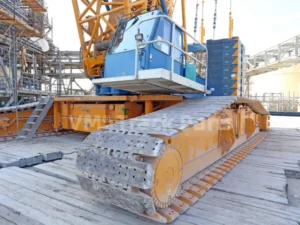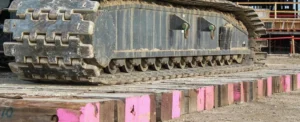
Giant crawler cranes are the core force for lifting heavy components at construction sites, energy projects, and large infrastructure construction sites around the world. However, the huge weight and concentrated loads of these behemoths pose a severe challenge to the ground. Crawler crane mats, seemingly simple engineering plates, have become key equipment for ensuring safety, improving efficiency, and protecting the environment in this context. This article will explore why pads are necessary and how to scientifically select the most suitable type of pads.
Why are pads necessary for crawler crane operations?
Distribute the load and prevent ground collapse: Crawler cranes have extremely high ground pressure, especially on soft, wet, or unstable ground (such as mud, sand, backfill, lawn, or paved roads), which can easily cause the crane to sink, tilt, or even overturn. Pads significantly reduce the unit pressure on the ground by expanding the ground contact area, ensuring that the crane has a stable foothold.
Ensure crane stability and operational safety: A stable foundation is a prerequisite for safe crane operation. Pads provide a flat, solid working platform for cranes, preventing dangerous shaking or tipping accidents caused by ground settlement or displacement during lifting, directly protecting operators, surrounding equipment, and project safety.
Protect underground facilities and completed ground: The huge pressure of heavy cranes may damage underground pipelines (cables, water pipes, gas pipelines) or infrastructure. When working on hardened roads (such as asphalt or concrete), pads can effectively disperse the load and prevent the road surface from being crushed or permanently deformed by crawlers.
Reduce damage to the environment: When working on non-hardened sites, pads can minimize the damage caused by cranes to surface vegetation and soil structures, helping to meet environmental regulations and site restoration standards.
Improve construction efficiency and equipment availability: Pre-laying pads can quickly create a safe working area and avoid expensive delays caused by cranes getting stuck and needing rescue due to ground problems. At the same time, protecting the ground also reduces the cost and time of later repairs.
Meet regulatory and insurance requirements: Safety regulations, lifting operation specifications, and insurance company clauses in many countries and regions require the use of standard crawler crane mats under specific ground conditions; otherwise, it may be considered an illegal operation and affect claims.

How to scientifically select the right crawler crane mats?
Selecting the right pad is not an easy task and requires comprehensive consideration of multiple factors:
Accurately calculate the crane load and ground bearing capacity:
Crane parameters: Obtain the maximum total weight of the crane (including counterweight), crawler size (length, width), ground contact area, and the maximum ground contact pressure specified by the manufacturer.
Ground survey: It is crucial! Conduct professional ground bearing capacity tests to determine soil type (clay, sand, silt, etc.), density, moisture, and bearing capacity. Consult a geotechnical engineer.
Calculate the required bearing capacity: Calculate the actual ground contact pressure based on the crane weight and crawler contact area to ensure that it is much lower than the bearing capacity that the ground can safely withstand after the pad is dispersed, and leave enough safety factor (usually requiring a safety factor of >1.5).
Evaluate the material and performance of the crawler crane mats:
Wooden pad:
Advantages: Relatively low cost, easy to obtain, and somewhat flexible.
Disadvantages: Relatively low strength and durability, susceptible to moisture, insect infestation, and rot, limited load-bearing capacity, and may not be uniform in size. Only suitable for light cranes or temporary, short-term, and low-load projects.
Steel pad:
Advantages: Extremely high strength, rigidity, and durability, huge load-bearing capacity, long service life, not easy to deform, can withstand extreme conditions, and provides optimal stability and safety. Surface anti-slip design is common.
Disadvantages: Large dead weight, auxiliary equipment (such as forklifts) is required for handling and laying, high initial cost, and anti-rust treatment is required.
Composite pad:
Advantages: Light weight (easy to carry manually), corrosion resistance, chemical resistance, good insulation, and usually recyclable. Excellent anti-slip performance.
Disadvantages: Creep may occur under long-term extreme loads, the maximum load-bearing capacity is usually lower than that of top-grade steel pads of the same size, and the cost may be higher.
Ultra-high-density polyethylene pads:
Advantages: Lightweight, corrosion-resistant, low-temperature resistant, non-conductive, good energy absorption, and low wear on the ground.
Disadvantages: The load-bearing capacity is usually lower than that of steel pads, and long-term exposure to high temperatures may affect performance.

Determine key size specifications:
Size: The length and width must be sufficient to cover the crane crawler and provide sufficient extension area around it to effectively distribute the load. Common sizes are 8′ x 14′, 8′ x 16′, 8′ x 18′, etc.
Thickness: Thickness directly affects stiffness and bending resistance. It must be calculated and selected based on the maximum load and span (the spacing between the crane crawlers or the spacing between the support points under the pad) to ensure that the pad will not bend excessively or even break. The thickness of steel pads usually ranges from 1/2 inch to 2 inches or even thicker.
Surface texture: Choose pads with effective anti-skid patterns (such as diamond plates and anti-skid strips) to prevent the crane crawler from slipping.
Consider the specific conditions of the project:
Operation cycle: For long-term projects, highly durable steel crawler crane mats are preferred; for short-term or frequently moved projects, lightweight composite materials or HDPE pads can be considered.
Ground type: Extremely soft ground may require a larger area or specially designed pad (such as a pad with a grid to increase grip).
Environmental factors: Corrosion resistance needs to be considered at the seaside or chemical plants (steel pads need to be coated or use composite materials/HDPE); cold regions need to consider the low-temperature brittleness of the material.
Handling and laying: Assess the on-site handling capacity (whether there is a forklift/crane). Lightweight pads are an advantage when there is no heavy equipment.
Conclusion
Crawler crane mats are by no means dispensable auxiliary equipment, but the core foundation for ensuring safe, efficient, and compliant heavy-lifting operations. Ignoring the necessity of pads or choosing the wrong pads can lead to catastrophic consequences and huge losses. By rigorously evaluating crane loads, ground conditions, and project requirements, and scientifically selecting pads with the right material, size, and quality, project managers can build a solid and reliable safety foundation for heavy lifting operations and ensure the smooth progress of the project.




